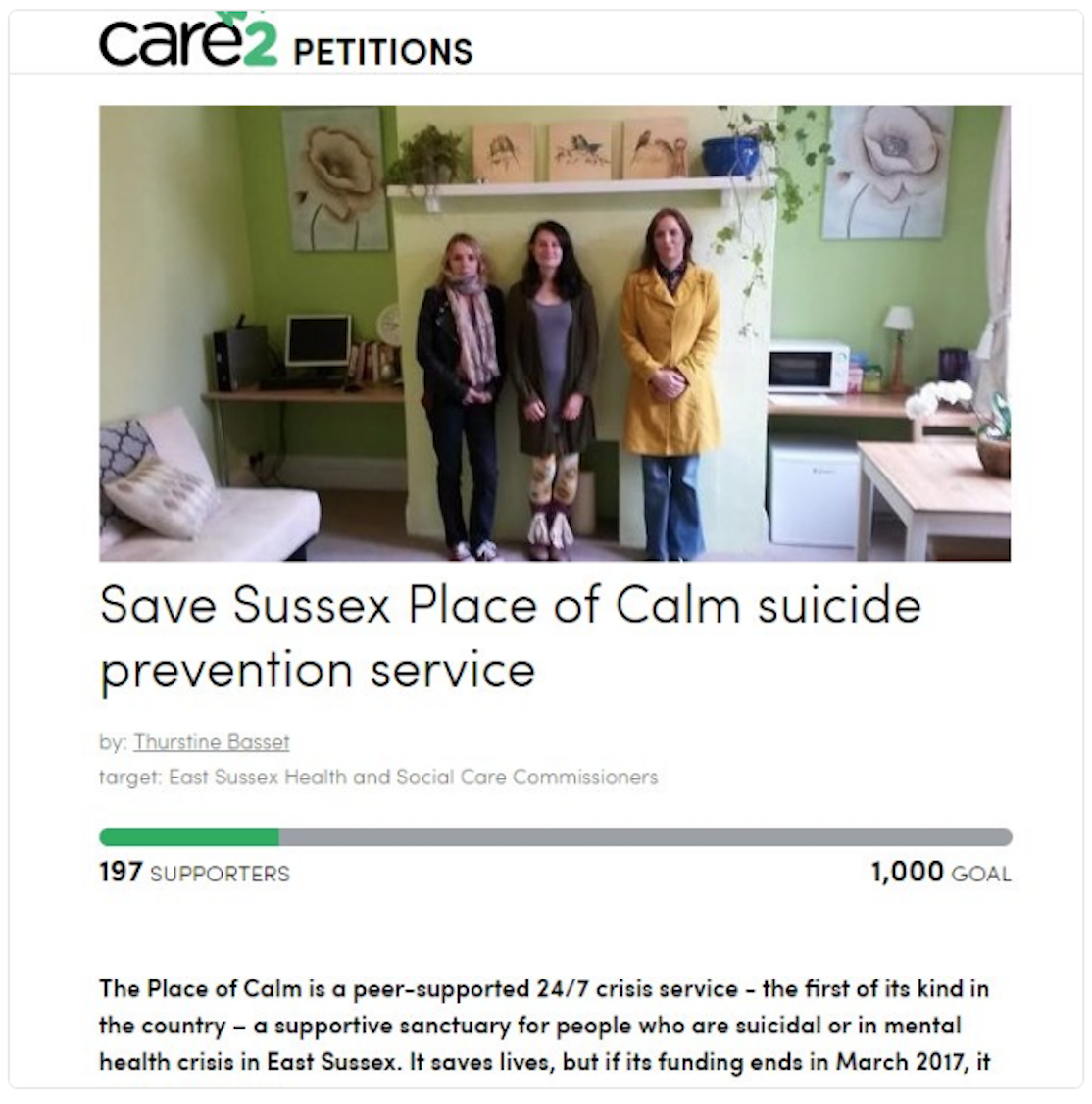On Monday 9th January 2017 Theresa May, Prime Minister, launched a package of measures to improve mental health across the UK. Speaking about preventing and reducing suicide, she committed her Government to providing:
“Further alternatives to hospital to support people in the community. Recognising that seeing a GP or going to A&E is not or does not feel like the right intervention for many people with mental ill-health, the government will build on its £15 million investment to provide and promote new models of community–based care such as crisis cafes and community clinics. The initial £15 million investment led to 88 new places of safety being created and the government now plans to spend up to a further £15 million to build on this success”
The very next day on Tuesday 10th January, the ‘Place of Calm’, a suicide prevention service in Eastbourne, a seaside town in Sussex, where incidentally Theresa May was born, was told by the local Commissioners, who fund mental health care, that their funding would be cut. This would require them to shut the service by the end of March 2017.
Two worlds — the world of the politicians and those who make policy completely at odds with the world of the people actually doing the work. I think it is pretty clear which of these two worlds constitutes what one might call ‘the real world.’
For me this was not a good start to 2017. 2016 had been a simply terrible year — starting with the death of David Bowie and going gradually downhill from there. 2016 ended for me with the news that a friend and colleague had taken his life on New Year’s Eve. He was a man under the age of 50 and had died in the way that is most common for men of his age in the UK. He had not been in touch with the Place of Calm. Perhaps, if he had been, he would still be alive today.
The Place of Calm is a peer-supported 24/7 crisis service and offers a supportive sanctuary for people who are suicidal or in mental health crisis in Sussex.
More than 30% of suicides take place in a public space. Sussex has a higher than average suicide rate in England, due mainly to the impact of Beachy Head, a public place widely used for suicide attempts. For the period 2006–2013 there were an average of 77 suicides per year in East Sussex.
People who have stayed at the Place of Calm have said:
“I cannot speak highly enough of my stay at the Place of Calm. I felt that I was given the space when I needed it and completely supported when I needed it too. I really appreciated not being judged by anyone and all my needs were met during my stay.”
“The staff went above and beyond, if it wasn’t for the support of the Place of Calm I don’t know where I would be, it was a life line for me. To have that as an alternative saved my life.”
“The staff were so kind and listened, it was a life saver.”
“If it were not for the Place of Calm that day I would have taken my own life. I would like to thank all that looked after and supported me during my stay which has led to me feeling so much better.”
The Place of Calm began as a pilot project in June 2015 and initial funding was continued until March 2017, but is now due to be withdrawn. This is such a waste of money as all the groundwork has been done and the service is operating well.
The Place of Calm’s innovative Peer Support Approach means suicidal people can stay up to 24 hours in a safe place in the community and receive practical and emotional support from trained professionals who have their own lived experience of mental health challenges.
The Place of Calm offers suicide prevention safety planning, emotional and psychological support, and practical support such as signposting, food, and a place to shower and sleep.
Over 70 people have stayed at the Place of Calm since it was set up, and follow-up surveys have shown that 100% of respondents said they were made to feel less suicidal, with 94% saying that Place of Calm ‘saved their life’ that day.
Studies show that most suicides are preventable. People with experiences diagnosed as “mental illness” are at higher risk of suicide, and the treatment and care they receive after making a suicide attempt is an important factor in reducing further suicide attempts.
Evidence suggests that not only does it save lives, the Place of Calm is cost effective, with calculations showing that for every £1 spent on the project, nearly £6 is saved from Health and Social Care spending. At a cost of just over £100,000 per year to run, the Place of Calm potentially saves public services £600,000 each year.
A 2016 evaluation by the University of East London (Briggs, Finch and Firth) demonstrated very positive results, showing that The Place of Calm:
- Has made a successful start as a new resource offering a different kind of support for suicidal people in East Sussex.
- Should become established on a permanent basis.
- Offers a helpful and distinctive model for people in suicidal crises, which is de-stigmatising and non-medical, and highly valued by people who stay there.
- Has robust qualities for working with suicidal people, and has the potential to be replicated elsewhere.
- Is recognised by referrers from Health Services, Street Triage and Approved Mental Health Professionals Service, and by the wider network of organisations involved in working locally with suicidal people, as a welcome, new resource that has an important role in the overall provision of resources to prevent suicide.
This is exactly the sort of service that everybody wants and has been calling for over very many years. I can remember that when I worked as a social worker in the 1970s, we argued for just such a service. Anne Cooke also covers this topic in writing about a crisis house in London in “I’d Rather Die Than Go Back to Hospital’: Why We Need a Non-medical Crisis House in Every Town.” (MadInAmerica October 28, 2015)
Currently there is a petition: We call on East Sussex Health and Social Care Commissioners to continue to fund the Place of Calm suicide prevention service.

If you are able to sign this petition it would be a great help. Thank you.















“Theresa May, Prime Minister, launched a package of measures to improve mental health across the UK.”
Well already this is wrong, psychiatric policing, acting like there is such a thing as mental illness.
RESIST, FIGHT BACK!
If people feel distress, its because they are the victims of social injustice. Punish the perpetrators, not the victims.
”
Hardly any of the ‘symptoms’ of psychological distress may correctly be seen as medical matters. The so-called psychiatric ‘disorders’ are nothing to do with faulty biology, nor indeed are they the outcome of individual moral weakness or other personal failing. They are the creation of the social world in which we live, and that world is structured by power.
Social power may be defined as the means of obtaining security or advantage, and it will be exercised within any given society in a variety of forms: coercive (force), economic (money power) and ideological (the control of meaning). Power is the dynamic which keeps the social world in motion. It may be used for good or for ill.
One cannot hope to understand the phenomena of psychological distress, nor begin to think what can be done about them, without an analysis of how power is distributed and exercised within society. Such an understanding is the focus of this web-site.
”
http://www.davidsmail.info/introfra.htm
Nomadic
Stop Supporting the Mental Health Industry, Please Join:
http://freedomtoexpress.freeforums.org/fighting-to-eradicate-the-mental-health-system-and-incarcerate-the-practitioners-f2.html
Report comment
Thanks for the good article. I’d add that your argument will be strengthened by noting that psychiatric patients are more likely to kill themselves AFTER a psych hospitalization than before. You might also want to note that the psych drugs sometimes make non-suicidal people suicidal, and a non-drug alternative is essential for people for whom the drugs either don’t work very well (a solid majority) or for whom drugs make the situation even more dire.
Of course, the real problem is that to fund these initiatives, money must be redirected from the ruling elite of psychiatrists and drug companies, and this will never be tolerated without a big fight. Sadly, the benefit of our rich elite is more important than the benefit of the patients they are supposed to be helping.
— Steve
Report comment